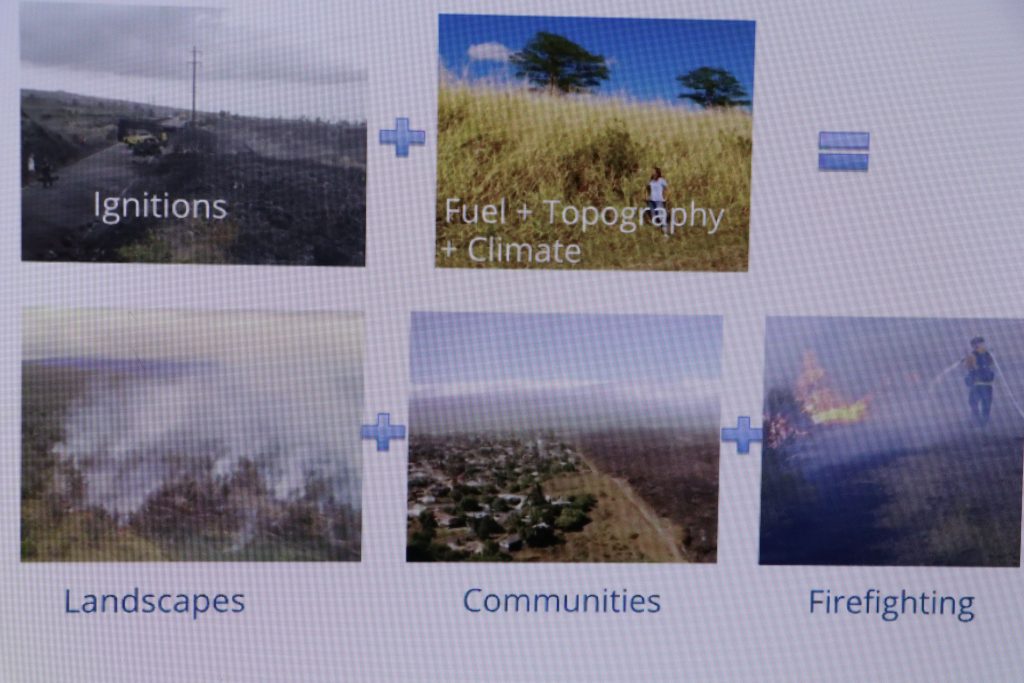Hawaii Department of Land and Natural Resources issued the following announcement on Nov. 14.
While organizers always hope for more people to participate, experience has shown that the first meeting of community members, experts, and researchers, to discuss wildfire, always leads to good things.
This morning a small group of people took the initial step toward developing a Community Wildfire Protection Plan (CWPP) for the north shore of O‘ahu, stretching from Ka‘ena Point to the edge of Kahuku and into the Ko‘olau Mountains.
Elizabeth Pickett, the co-executive director of the Hawai‘i Wildfire Management Organization (HWMO), outlined the steps other communities have already gone through to prepare a CWPP. The Honolulu Fire Department and the DLNR Division of Forestry and Wildlife (DOFAW) will be signatories of the plan, as primary wildland fire responders on O‘ahu. DOFAW is funding the development of the CWPP and HWMO is coordinating it.
CWPPs are the result of 2003 federal legislation. The Federal Emergency Management Agency (FEMA) leads community wildfire protection planning nationally. The FEMA website says wildfire actions plans are one of the most important components of a wildfire safety strategy in a community. According to the U.S. Forest Service, less than 10% of communities at risk from wildfire have developed a CWPP. It is hoped, people from the broad north shore community will be inspired and energized to participate in the CWPP. Pickett said it is less of a plan and more the mechanism to start the conversation about wildfire. “We’ve seen this process lead to transformative change on the ground.” The workshop included three break-out sessions where participants could engage, collaborate, and discuss wildfire issues more specifically.”
Statewide, sixteen Hawai‘i communities have CWPPs, including west O‘ahu. While that part of the island tends to be dryer than the north shore, Dr. Clay Trauernicht, an ecosystem fire expert with University of Hawaiʻi Cooperative Extension, showed a series of slides depicting numerous wildfires within the boundaries of the proposed CWPP. He explained how the north shore, like many places here and across the world, are experiencing more severe wet and dry cycles. Fire seasons are longer, and fires tend to be more intense. Trauernicht said, “Climate change is now a factor and the north shore has a complex, diverse landscape; a mix of forest and grass lands.”
Part of developing a CWPP is to do a risk assessment to identify the hazard levels for different areas and introduce site-specific actions to create more resilient landscapes, fire-adapted communities, and safe and effective firefighting. When a CWPP is in place, communities can apply for grants to help fund projects.
Before participants clicked into three breakout groups, Pickett said, “It takes everybody doing their part to make sure that lands and waters are safe and resilient. That comes through thinking together.” Describing this first step toward having a CWPP plan for the north shore, she concluded, “This is what it looks like when we have an initial, engaged group.”
Learn more about Community Wildfire Protection Plans at: https://www.hawaiiwildfire.org/
Original source can be found here.

Source: Hawaii Department of Land and Natural Resources


 Alerts Sign-up
Alerts Sign-up